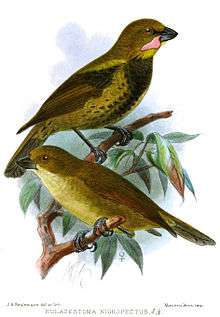Wattled ploughbill
| Wattled ploughbill | |
|---|---|
 | |
| Scientific classification | |
| Kingdom: | Animalia |
| Phylum: | Chordata |
| Class: | Aves |
| Order: | Passeriformes |
| Family: | Eulacestomidae |
| Genus: | Eulacestoma De Vis, 1894 |
| Species: | E. nigropectus |
| Binomial name | |
| Eulacestoma nigropectus De Vis, 1894 | |
The wattled ploughbill (Eulacestoma nigropectus) is a small, approximately 14 cm long, olive-brown songbird with a strong, thick, wedge-shaped black bill, used to plough into dead tree branches, bark and twigs in search for its insects diet. The sexes are different. The male has black underparts, black wings and a large circular pink wattle on the cheek. The female has olive green plumage and pale olive below. Only the adult male has wattles.
The only member of the monotypic genus Eulacestoma and family Eulacestomidae, the wattled ploughbill is distributed and endemic to central mountain ranges of New Guinea. The diet consists mainly of insects.
Widespread throughout its large range, the wattled ploughbill is evaluated as least concern on the IUCN Red List of Threatened Species.
References
- ↑ BirdLife International (2012). "Eulacestoma nigropectus". IUCN Red List of Threatened Species. Version 2013.2. International Union for Conservation of Nature. Retrieved 26 November 2013.
- del Hoyo, J.; Elliot, A. & Christie D. (editors). (2007). Handbook of the Birds of the World. Volume 12: Picathartes to Tits and Chickadees. Lynx Edicions. ISBN 978-84-96553-42-2
